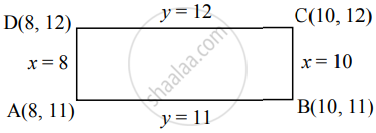Advertisements
Advertisements
Question
Answer the following question:
Find the equations of the diagonals of the rectangle whose sides are contained in the lines x = 8, x = 10, y = 11 and y = 12
Solution
Given, equations of sides of rectangle are x = 8, x = 10, y = 11 and y = 12

From the above diagram,
Vertices of rectangle are A(8, 11), B(10, 11), C(10, 12) and D(8, 12).
Equation of diagonal AC is
`(y - 11)/(12 - 11) = (x - 8)/(10 - 8)`
∴ `(y - 11)/1 = (x - 8)/2`
∴ 2y – 22 = x – 8
∴ x – 2y + 14 = 0
Equation of diagonal BD is `(y - 11)/(12 - 11) = (x - 10)/(8 - 10)`
∴ `(y - 11)/1 = (x - 10)/(-2)`
∴ –2y + 22 = x – 10
∴ x + 2y = 32
APPEARS IN
RELATED QUESTIONS
Write the equation of the line :
parallel to the X−axis and at a distance of 5 unit form it and above it
Obtain the equation of the line :
parallel to the X−axis and making an intercept of 3 unit on the Y−axis
Obtain the equation of the line containing the point :
A(2, – 3) and parallel to the Y−axis
Find the equation of the line containing the origin and having inclination 60°
Find the equation of the line passing through the origin and parallel to AB, where A is (2, 4) and B is (1, 7)
Find the equation of the line containing point A(3, 5) and having slope `2/3`.
Find the equation of the line passing through the origin and which bisects the portion of the line 3x + y = 6 intercepted between the co-ordinate axes.
Find the equation of the line having inclination 135° and making X-intercept 7
The vertices of a triangle are A(3, 4), B(2, 0), and C(−1, 6). Find the equation of the line containing side BC.
The vertices of a triangle are A(3, 4), B(2, 0), and C(−1, 6). Find the equation of the line containing the midpoints of sides AB and BC
Find the x and y intercept of the following line:
`(3x)/2 + (2y)/3` = 1
Find the x and y intercept of the following line:
2x − 3y + 12 = 0
Find equations of lines which contains the point A(1, 3) and the sum of whose intercepts on the coordinate axes is zero.
Find equations of lines containing the point A(3, 4) and making equal intercepts on the co-ordinates axes.
Find equations of altitudes of the triangle whose vertices are A(2, 5), B(6, –1) and C(–4, –3).
Find the coordinates of the orthocenter of the triangle whose vertices are A(2, −2), B(1, 1), and C(−1, 0).
N(3, −4) is the foot of the perpendicular drawn from the origin to line L. Find the equation of line L.
Answer the following question:
Does point A(2, 3) lie on the line 3x + 2y – 6 = 0? Give reason.
Answer the following question:
Find the equation of the line having slope 5 and containing point A(–1, 2).
Answer the following question:
Find the equation of the line through the origin which bisects the portion of the line 3x + 2y = 2 intercepted between the co−ordinate axes.
Answer the following question:
The vertices of a triangle are A(1, 4), B(2, 3) and C(1, 6). Find equations of the medians.
Answer the following question:
The vertices of a triangle are A(1, 4), B(2, 3) and C(1, 6) Find equations of altitudes of ∆ABC
Answer the following question:
Find the X−intercept of the line whose slope is 3 and which makes intercept 4 on the Y−axis
Answer the following question:
Two lines passing through M(2, 3) intersect each other at an angle of 45°. If slope of one line is 2, find the equation of the other line.
Answer the following question:
Find the Y-intercept of the line whose slope is 4 and which has X intercept 5
Answer the following question:
Find the co-ordinates of the foot of the perpendicular drawn from the point P(−1, 3) the line 3x − 4y − 16 = 0
Answer the following question:
The perpendicular from the origin to a line meets it at (−2, 9). Find the equation of the line.
Answer the following question:
Show that there are two lines which pass through A(3, 4) and the sum of whose intercepts is zero.
The lines `(x + 1)/(-10) = (y + 3)/-1 = (z - 4)/1` and `(x + 10)/(-1) = (y + 1)/-3 = (z - 1)/4` intersect at the point ______
The slope of normal to the curve x = `sqrt"t"` and y = `"t" - 1/sqrt"t"`at t = 4 is _____.
The point A(b, a) lies on the straight line 2x + 3y = 13 and the point B(a, b) lies on the straight line -x + 4y = 5, then the equation of line AB is ______
The line L given by `x/5+y/b=1` passes through the point (13, 32). The line K is parallel to L and its equation is `x/c+y/3=1`. Then, the distance between L and K is ______.
Let the perpendiculars from any point on the line 7x + 56y = 0 upon 3x + 4y = 0 and 5x – 12y = 0 be p and p', then ______.
Area of the parallelogram formed by the lines y = mx, y = mx + 1, y = nx and y = nx + 1 is equal to ______.
N(3, – 4) is the foot of the perpendicular drawn from the origin to a line L. Then, the equation of the line L is ______.
